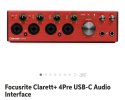Fowleri
Inspired
For example if I buy an FM3
And I connect it to my audio interface via spdif vs connecting to the XLR outputs.
What’s the main difference?
Would the spdif be “balanced”
If I connect FM3 balanced XLR outputs to my interface balanced TRS outputs with XLR to TRS cables, then I will have a balance connection between FM3 and audio interface
Whats the difference if I use spdif connection instead. Many interfaces have spdif in and out, optical, etc.
Would the sound quality be worse on spdif? What are the advantages and disadvantages
The advantage is that is just one cable and frees up TRS outputs on your interface for other stuff
And I connect it to my audio interface via spdif vs connecting to the XLR outputs.
What’s the main difference?
Would the spdif be “balanced”
If I connect FM3 balanced XLR outputs to my interface balanced TRS outputs with XLR to TRS cables, then I will have a balance connection between FM3 and audio interface
Whats the difference if I use spdif connection instead. Many interfaces have spdif in and out, optical, etc.
Would the sound quality be worse on spdif? What are the advantages and disadvantages
The advantage is that is just one cable and frees up TRS outputs on your interface for other stuff


